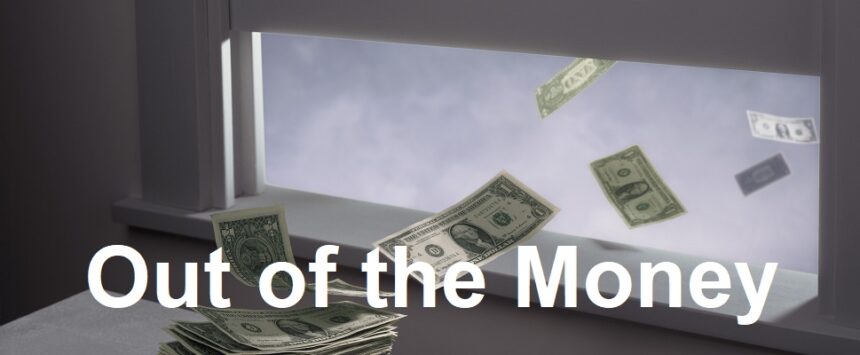Out of the money is a term in options, there are two out of the money conditions, namely the buy option, known as a put option, and the sell option known as call options. Both can experience out of the money. In a put option transaction, put of the money is a condition where the price of the stock or underlying asset of the option is below the strike price, known as the strike price. Meanwhile, in call option transactions, out of the money is a condition where the price of the stock or underlying asset of the option is worth higher than the agreed price. A put option is an option where investors expect the price of the underlying asset to increase, because the increase in the price of the underlying asset above the strike price gives investors the opportunity to make a profit, which is obtained from the difference between the strike price and the market price of the underlying asset. On the other hand, a call option is a type of option where the investor expects the price of the underlying asset to decrease, because the investor makes a profit if the price of the underlying asset is lower than the strike price.
The out of the money condition which is abbreviated as OTM causes an option, be it a put option or a call option, to have no intrinsic value, so that the right to buy the option is not feasible to take, because it does not provide a profit, even if it is taken it will only result in the trader or investor loss. Fortunately, in options investors are not forced to buy the underlying asset, because options are rights not obligations. If an option is OTM the investor does not need to take this buying right.
The opposite of out of the money is in the money (ITM), which is a condition when the market price of the underlying asset of an option is above the strike price for a put option, and below the strike price for a call option. In the in-the-money condition, the investor has the opportunity to make a profit when the option expiration date arrives. ITM has intrinsic value and extrinsic value, while OTM has no intrinsic value, only extrinsic value. Intrinsic value is the economic value of an option if the right is exercised, this intrinsic value is the difference between the strike price and the market price of the underlying asset. What if the difference between the strike price and the market price is negative? This condition makes the intrinsic value of an option zero. Options that are in OTM have no intrinsic value, only have extrinsic value, so what is the extrinsic value of an option?. Extrinsic value is the price difference between the market price and the strike price of an option. Also known as the premium price because it makes the strike price more expensive than the market price.
Basically, the term Out of the Money (OTM) is an option that has no intrinsic value. That is, if it is done by the holder, they will not receive anything. If it is a call option, it is considered out of the money if the price of the underlying asset is below the strike option price. And if it is a put option, it is considered out of the money if the price of the underlying asset is higher than the price of the strike option.
Say you are going to buy a call option with a strike price of $102 for a stock that is currently trading at $100. If the stock stays below your $102 strike price until the option expires then the option will expire out of the money. This means the option expires worthless and the buyer loses whatever they paid to buy the option. The same can happen for a put option, if the stock is trading at $100 and you buy a put option with a strike price of $97, you will lose your investment if the stock price is above $97 at the end of the contract because the option will expire and become unusable or useless.
How important is the Out of the Money option? Well, having an option out of the money means you will lose the premium paid to buy the option, and losing money is not a good thing. However, it is better than if you lose the value of the underlying asset and that is why this option is often used by investors to hedge against adverse moves in existing investments.
Characteristics of Out of the Money
Because they have relatively low premiums and add leverage to trades, out of the money options are often attractive to hedgers and speculators. You will usually find that OTM options are cheaper than ITM options because you are not paying any intrinsic value, as OTM options consist entirely of time value. Because of this, the time decay rate in OTM options is often very fast and expensive, especially when considered on a percentage basis. This is true even when the option is very far from expiring.
Since OTM options have very low premiums, they can also provide traders with a significant amount of leverage as you can control large positions with small premiums. However, it is also true that OTM options are less sensitive to price movements than ITM or ATM options. The further away from the money an option becomes the less sensitive it becomes to price movements in the underlying asset. On the other hand, OTM options can be very sensitive to market volatility and this is because the entire value of OTM options is made up of time values. This means that OTM options are often used by speculators in volatility-based trading.
Out of the Money Advantage
Out of the money options usually have the largest percentage gain when the price of the underlying asset moves, which makes them more attractive to them than ATM or ITM options.
The out of the money option has a lower premium when compared to the ATM and ITM options.
Disadvantages of Out of the Money
When the OTM option expires, you lose all your premiums.
There is a greater chance that you will suffer a loss with an OTM option because the price of the underlying stock will need to move significantly to bring the option into money and make it profitable.






















